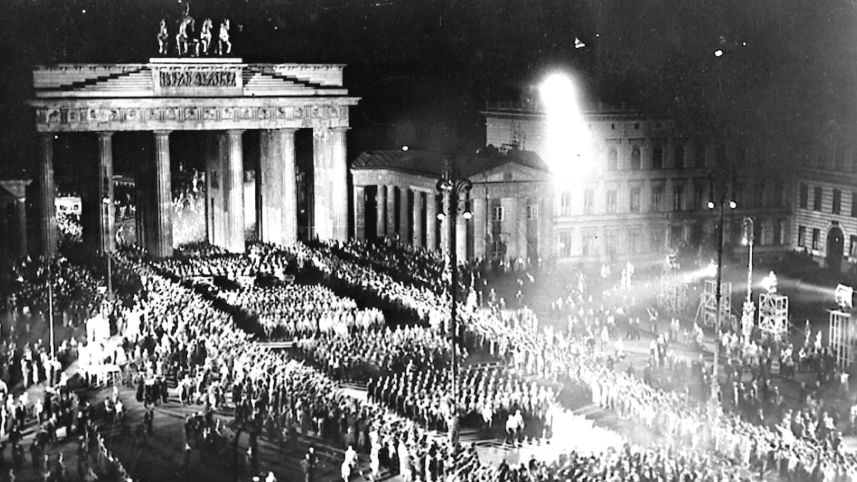Fearing Jewish-led boycotts, Germany signed the Transfer Agreement, letting 60,000 beleaguered German Jews to reach Palestine, with their money no less.

The rise of Nazi Germany: National Socialist troops with torches marching in Berlin to celebrate Hitler taking over the power to Jan. 30, 1933. In background is the Brandenburg Gate. Credit: AP
August 25, 1933, is the date of the signing of the Transfer Agreement, which enabled 60,000 German Jews to leave for Palestine while taking some of their money with them. It is a deal that remains controversial to this day. The signatories to the agreement were the Anglo-Palestine Bank (a Zionist institution), the German Zionist Organization and the Nazi German Economics Ministry.
Even at this very early stage of the Nazi rise, for some Jews, simply negotiating with the regime was akin to dealing with the devil.
Almost immediately after Adolf Hitler formed a government, in late March 1933, it began to take measures to expunge Germany’s 525,000 Jews from society and from the economy. Violence against Jews also became common, especially after Hitler’s number two, Hermann Goering, declared that “I refuse to turn the police into a guard for Jewish stores.”
Quaking before Jewish-led boycotts
Germany of late March 1933 was under some economic stress. The Jews of Poland had begun to boycott German products, and American Jews were making efforts to have their community do the same.
One of the new Nazi government’s first missions was to restore economic health to the country, and it had an exaggerated fear of the ability of Jewish boycotts to foil that undertaking.
At the same time, Jews who were prescient enough to want to get out of Germany at this early date faced existing laws that prohibited them from taking currency out of the country. From the German point of view, if the Zionist leadership in Palestine would countenance a plan to buy and import German products, it could undermine a coordinated economic boycott of the Reich.
The inspiration for the Transfer Agreement was a private initiative proposed by Sam Cohen, owner of the Hanotea citrus-export company in Netanya. Cohen negotiated directly with the German Economics Ministry, which agreed to allow Jews considering leaving Germany to deposit money, up to 50,000 Reichsmarks per family, into one of two different accounts in the Reichsbank. That money would then be used to purchase and export to Palestine agricultural equipment produced in Germany and needed by Hanotea. When they arrived in the Land of Israel, the Jews would be reimbursed by the company in local currency. The arrangement also allowed each departing Jew to take up to 1,000 pounds sterling.
It was something of a win-win scheme. On July 18, Cohen and the Germans renegotiated it upward, so that it covered a total of 3 million Reichsmarks, in place of the original 1 million.
Mixed feelings in Palestine
In the Yishuv, the Jewish community in Palestine, feelings about the agreement split along political lines.
The Revisionists, on the right, were completely opposed to making any deals with the Germans. But the Labor figures who controlled the Zionist Organization were impressed with the deal made by Sam Cohen, and at the same time, they wanted to coopt it.
Almost immediately, Zionist executives began talking with the German consul in Jerusalem. It was quickly agreed that the agreement would be expanded, but with the Jewish side represented not by a private corporation but by the Zionist institutions, including the Anglo-Palestine Bank, a subsidiary of the Jewish Agency.
It was the new agreement that was enacted on August 25, 1933.
By most accounts, during the half-dozen years that the arrangement was in effect, the Transfer Agreement was mutually beneficial. Some 60,000 Jews, out of a total pre-1933 Jewish population of 525,000, were able to leave the country with at least some of their assets, an estimated 140 million Reichsmarks, up to September 1939. . They brought those assets to the Jewish state-in-the-making. At the same time, the sales of German industrial products to Palestine constituted a net economic gain for Germany, though, as some noted, it also helped undermine any boycott of Germany.
According to a report from the Jewish Telegraphic Agency in March 1938, by 1939, the Agreement was on its last legs. The German economy, it noted, was now being powered by the country’s rearmament project, with war industries providing jobs to many who had been unemployed. Second, foreign currency was now a priority for Germany, and this was a need that the Transfer Agreement didn’t answer.
Originally Published HERE








